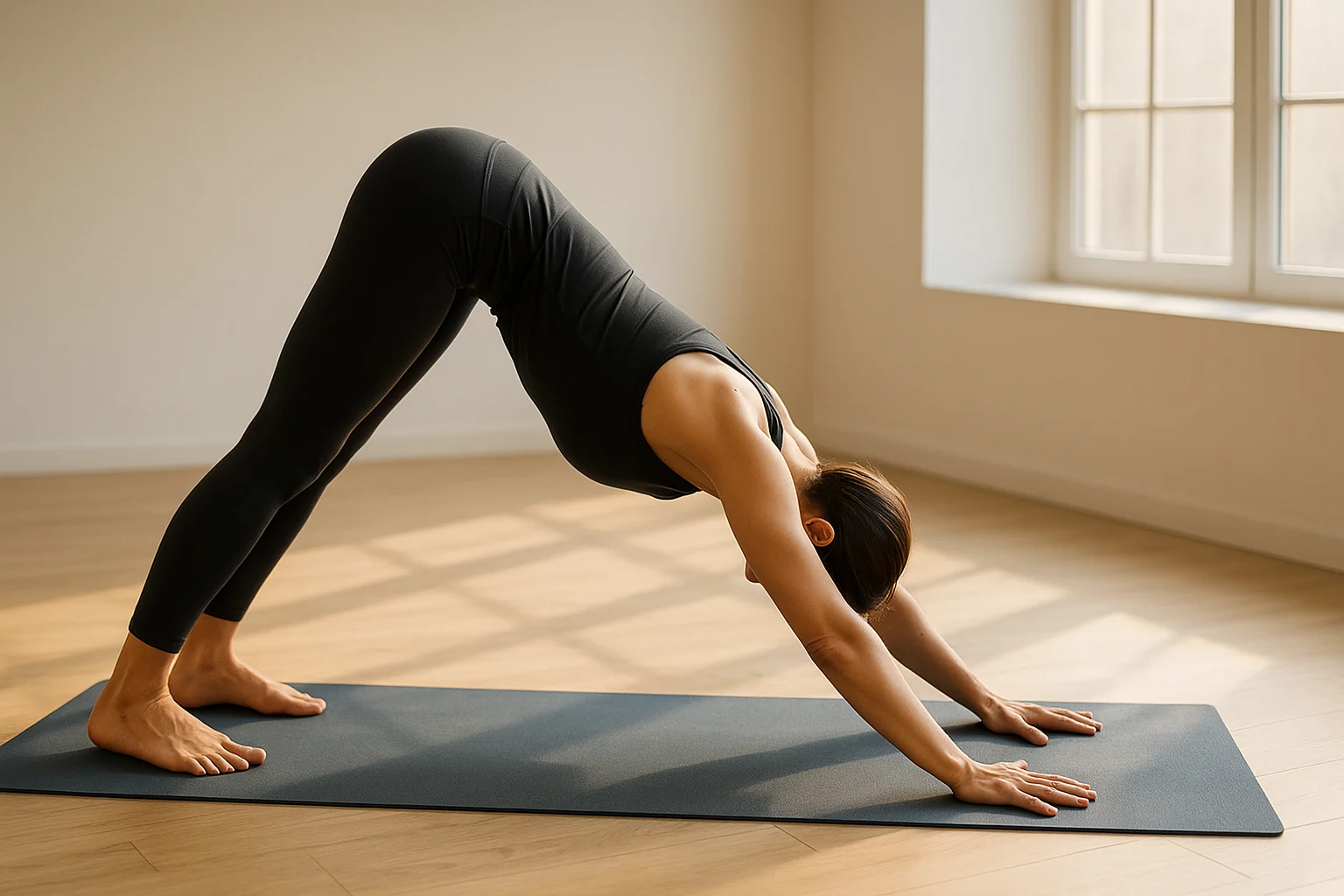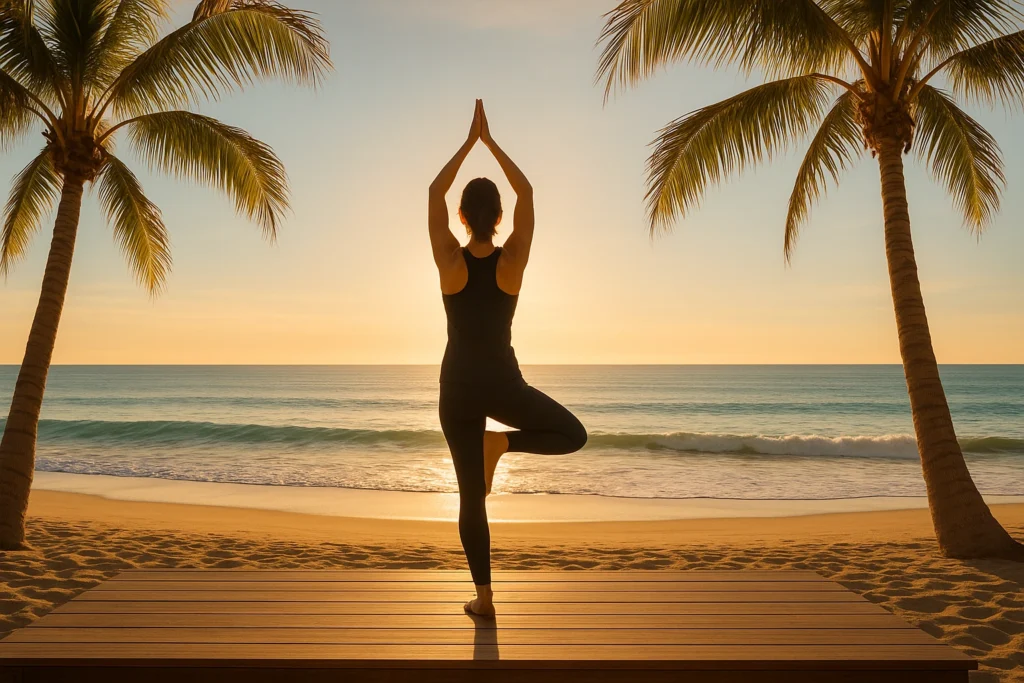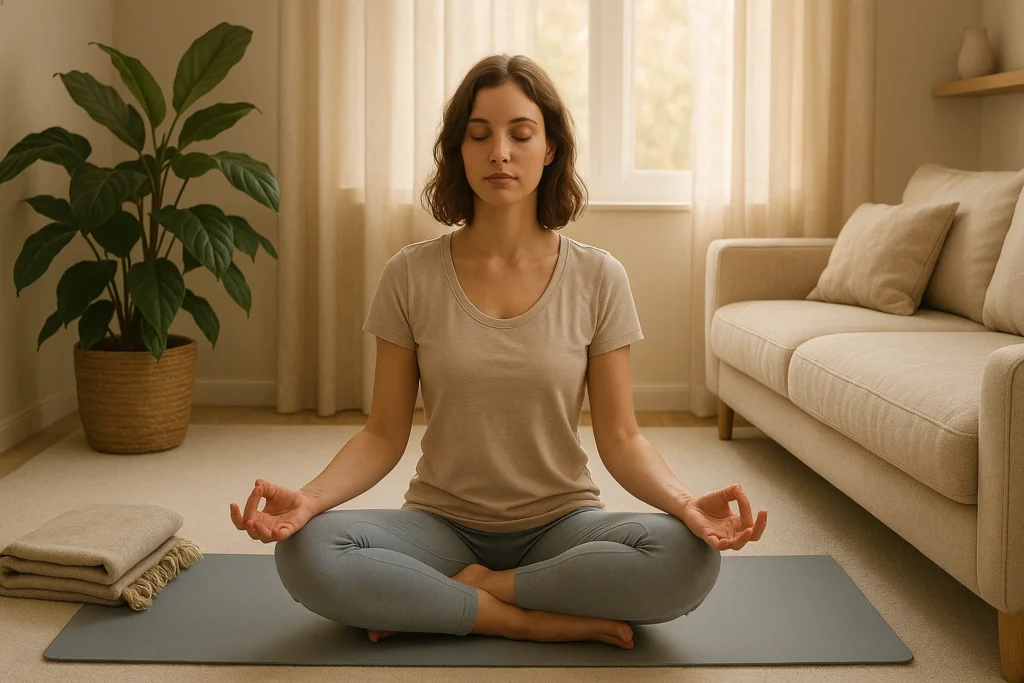
Want to practice yoga without pain and move with ease? Start with yoga alignment principles. A few small tweaks can make every pose feel safer and more empowering. This guide shares clear cues for proper yoga posture to deepen your practice, prevent injuries, and connect mind and body, complementing our comprehensive yoga philosophy guide.
Assess Your Alignment Now!Key Takeaways: Yoga Alignment Principles at a Glance
- Grounding: Find your base. Press evenly through feet or hands so the pose feels steady, not wobbly.
- Long Spine: Create length from tailbone to crown to protect your back and open space between vertebrae.
- Joint Stacking: Knees over ankles, shoulders over wrists—simple lines that save your joints.
- Breath Leads: Inhale to create space, exhale to settle deeper. Let breath set the pace.
- Energy Flow: When the shape is aligned, prana moves more freely—and the pose feels alive.
Core Yoga Alignment Principles: Your Blueprint for Asana Safety
Alignment is your roadmap for safe, efficient movement. Whether you’re flowing through Vinyasa or holding an Iyengar-style shape, clear lines in the body help you build strength, avoid strain, and go deeper without forcing it.

1. Grounding: Finding Your Roots 🌳
Grounding is how you “plug in” to the floor. In Mountain Pose, spread your toes, press the four corners of each foot, and feel your arches lift. In Down Dog, root through your knuckles and lengthen through the hips.
Do this:
- Standing Poses: Spread your toes, lift your arches, and distribute weight evenly. Imagine roots growing into the earth.
- Seated Poses: Root your sit bones, lengthening your spine upward.
- Inversions: In Downward Dog, press through your knuckles and spread fingers wide for a solid base.
Why it matters: A stable base calms the nervous system and frees the rest of the body to move.
2. Spinal Elongation: Creating Space and Lightness 📏
Think “long, not rigid.”
Do this:
- Warrior I: Lift through the crown as your ribs soften down.
- Twists: Inhale to lengthen, exhale to rotate from the mid-back (not the neck).
- Forward folds: Hinge at the hips and keep the back broad; bend knees as needed.
Why it matters: Length creates space for discs, helps posture, and makes breathing easier.
3. Joint Safety: Protecting Your Body’s Hinges 🛡️
Simple stacks beat flashy shapes. Proper alignment protects knees, hips, shoulders, and wrists from strain, especially in poses like Plank or Warrior II where wrist pain can arise if misaligned. For targeted relief, explore our guide on yoga for wrist pain relief.
Cues that work:
- Knees: In Warrior II, front knee tracks over second toe; keep a micro-bend in “straight” legs.
- Shoulders: In Down Dog, externally rotate upper arms and draw shoulder blades slightly down.
- Wrists: In Plank, press through knuckles and spread fingers; try forearm plank if wrists are sensitive.
- Hips: In Pigeon, square the pelvis rather than cranking the front knee.
Why it matters: Clean lines reduce shear stress and help you build strength safely over time—this is the heart of proper yoga alignment.
This post has affiliate links. We may earn a commission. Learn more.
CBD Freeze Roll-On
Post-practice wrists or tight neck? A quick roll can be a calming part of cool-down—framed as “may help with everyday discomfort.”
Try the Roll-On Partnered
No discount code needed — just click and explore.
Not medical advice; consult a healthcare professional for personal guidance.
4. Breath Integration: The Rhythm of Your Practice 🌬️
Breath is your built-in metronome, guiding movement and deepening sensations, often enhanced by using yoga props like blocks to support proper form.
Try this:
- Inhale to create space: Cobra or Low Lunge—lift and lengthen.
- Exhale to deepen: Soften into the shape without collapsing.
- Ujjayi (optional): Gentle throat whisper to steady focus in flowing sequences.
Why it matters: When breath leads, your muscles recruit more intelligently and the mind settles. For more on pranayama, explore resources from Yoga International.
5. Energy Flow: Unlocking Your Inner Current ✨
When aligned, your body lets prana (life force) flow freely through nadis (energy channels). In Warrior II, feel energy extend from your back foot to your fingertips, creating openness.
Try this:
- Active Engagement: Engage muscles to feel lightness, like lifting through your core in Boat Pose.
- Balanced Effort: Find ease (sukha) and strength (sthira) in every pose.
- Mindful Awareness: Sense energy moving through your body, enhancing vitality.
Why it matters: Free-flowing energy boosts mental clarity and well-being, turning poses into moving meditation.
6. Alignment for Advanced Poses
For advanced practitioners, asana alignment is crucial in complex poses. In Handstand, stack shoulders over wrists to protect joints and maintain balance. In Crow Pose, engage your core to lift your hips, ensuring stability. These tweaks allow safe progression without strain.
Why Yoga Alignment Matters (Beyond Aesthetics)
Good alignment isn’t about picture-perfect shapes. Thoughtful yoga posture alignment helps you feel stable, pain-free, and present—on the mat and in daily life.

Injury Prevention 🛡️
Most aches trace back to small alignment leaks. Hyperextended knees, collapsed arches, or rounded low backs add up. Simple fixes—like stacking knee over ankle in lunges or bending the knees in forward folds—often resolve discomfort quickly.
Deeper Poses and Strength 💪
When your base is steady and the spine is long, strength builds where you want it—glutes, core, back—rather than in your neck or wrists. That foundation makes transitions to poses like Crow or Handstand feel gradual and doable.
Enhanced Mind-Body Awareness 🧠✨
Focusing on alignment—like the curve of your spine in Child’s Pose—cultivates mindfulness. This awareness extends off the mat, improving posture in daily life.
Common Alignment Mistakes and How to Fix Them
Even seasoned yogis slip up. Here are common pitfalls and fixes to keep your practice safe.
- Rounding the Lower Back in Forward Folds: Hinge from your hips, not your waist. Bend knees to keep your spine long, like reaching your tailbone back in Seated Forward Fold.
- Hyperextending Knees: Keep a micro-bend in “straight” legs to protect joints, especially in Triangle Pose.
- Shoulders by Ears: In Down Dog, draw shoulder blades down to release neck tension. Your shoulders will thank you!
- Collapsing Foot Arches: Lift arches by engaging shin muscles, grounding the base of your big toe in Warrior II.
- Lack of Core Engagement: In Plank, draw your navel to your spine to support your lower back. No sagging!
Alignment Self-Check Tool 🧘♀️
Use this yoga form guide and interactive quiz to check your alignment. Click an answer for each question to evaluate your practice and get personalized tips.
Feeling stable, distributing weight evenly, engaging roots.
Yoga Posture Alignment: Practical Tips
Yoga Form Guide: Quick Cues
Mastering alignment is a journey. Here’s how to embody these principles, with guidance from a yoga teacher training program if you want deeper insights:
- Listen to Your Body: Pain signals a need for adjustment. For example, ease off if your knees hurt in a lunge.
- Build from the Ground Up: Start with a stable base in poses like Warrior II to ensure safety.
- Use Props: Blocks and straps bring the ground closer, helping you align without strain in poses like Triangle.
- Seek Expert Guidance: A qualified teacher can refine your form, especially in complex poses like Bridge.
- Practice Mindfully: Use a mirror occasionally to check alignment, like shoulder placement in Down Dog.
- Be Patient: Celebrate small wins, like feeling steadier in Tree Pose, and keep refining.
Frequently Asked Questions
Conclusion: Your Journey to Aligned Practice
Keep it simple: steady base, long spine, smart stacks, breath first—the backbone of proper yoga alignment. Tweak one cue per session and let progress build. Your body will thank you.
If you have injuries or medical conditions, check in with a qualified healthcare professional or an experienced yoga teacher before changing your practice.


